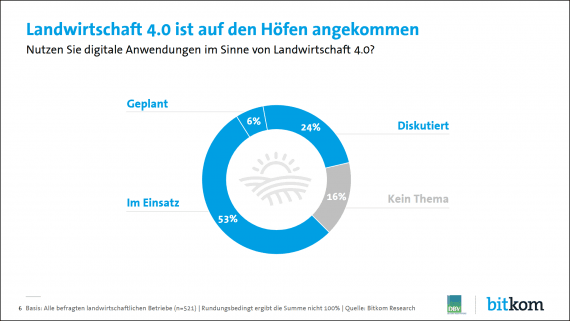
10 trend terms of digital farming and agtech explained
The terms of digitization trends are now spilling over into our industry. To clear up the jungle, we’ve explained 10 frequently used terms.
The future trend of digital agriculture is based on one major concept: smart or precision farming. This primarily refers to processes and solutions that deal with data, are often Internet-based and aim to measure, control and optimize agricultural processes.
The following graphic of a german survey of bitkom shows that already 53% of the farmers use digital farming applications, 24% are discussing it, 6% plan to implement something and 16% don’t see it as suitable invest at all.

They range from technical hardware such as satellites or GPS, drones, robotics and sensors to software that builds on them, such as apps or online platforms. According to Bitkom, apps are the most commonly used software, followed by “intelligent software” (e.g. installed in agricultural machinery for driver assistance) and farm management platforms. In terms of hardware, it is mainly high-tech agricultural machinery and automatic feeders that are in use. Robotics and drones are used only sporadically. In animal production, however, every second farmer decides in favor of an automatic milking system when making a new investment
Crop production
Livestock farming
Farm management
In both crop production and animal production, the development of links between these technologies and with other systems (e.g. the weather service) remains on the agenda of agricultural companies. Data management, i.e. data acquisition/collection and subsequent evaluation, is an important part of this. New technologies, such as the Big Data approach, are essential for this. All with the aim of offering the user, the farmer, the best possible basis for decision-making and support in everyday work.
… therefore lie primarily in improving the quality of work, occupational health and safety, and making work easier. Monotonous and stressful routine work is taken over by a robot or other technology. This also makes working hours and the place of work more flexible. In the best case, not only can precision and animal welfare be increased, but the environment can also be protected through the optimized use of resources/operating materials. With the help of appropriate management systems, operating processes can also be made more efficient and better monitored, thus also improving cost efficiency, for example.
“Modern agriculture is exposed to increasing quality requirements, growing price pressure, international competition and high expectations in environmental and animal protection. The use of data-driven solutions, the monitoring of (real-time) data and the associated rapid action in case of emergency allow a serious increase in resource efficiency and provide the farmer with the tools to successfully meet the above challenges.” – Smartbow
It remains to be seen how the agriculture of digital solutions will develop. Opportunities and risks must be weighed up for one’s own business and the right solution found that does not overtax, but above all supports. It is not only the digitizers who are in demand, but also you as a user, because you help determine what makes sense for your everyday work today and in the future – remember: The future of agriculture begins today and you are part of it.

10 trend terms of digital farming and agtech explained
The terms of digitization trends are now spilling over into our industry. To clear up the jungle, we’ve explained 10 frequently used terms.

Digital learning: advanced education in german-speaking agriculture
What kind of online education offers are there, how do they differ and what should you look for when choosing?

Tips for the digital farm office
Between storage obligations, paper chaos and office frustration – Can a digitalized agricultural office help?
Copyright © 2023 NDL. All rights reserved. | Privacy Policy | Imprint | Cookies